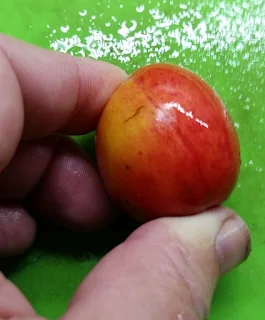 |
| See the suture line? |
 |
| South Dakota is a freestone. That means the stone lifts right out of the ripe, cut halves. |
 |
| I was harvesting the seeds for planting but could not bring myself to eat four pounds of plums in one sitting nor to throw them away. |
 |
| Cold-pack pints are 25 minutes of boiling. Then I took the jars and the kettle outside to cool off. Our A/C does not need the extra load. |
Bonus factoid
Sphere packing is not very efficient. Shot in shotshells and fruit in jars will run about 60%-to-65% efficient.
Why might that be useful?
Suppose you were reloading 20 gauge hulls that somebody had given you as a gift. Also suppose that your standard "load" is just a bit too bulky.
You cut off the petals of the wad and weigh them and learn they are 9 grains.
How many #8 pellets does that equate to?
Since the wad is made of low-density polyethylene with a density of approximately 1.0 grams per cc and lead has a density of approximately 11 grams per cc, if spheres packed perfectly efficiently then the petals would be the equivalent of 11 * 9 grains or 99 grains of pellets. At 1.1 grains per pellet of #8 shot, that would be 90 pellets.
But since we know spheres are not very efficient at packing, we have to multiply that 90 pellets (100% efficiency) by something between 60% and 65%.
If we use 60% we get 54 additional pellets. If we use 65% the math predicts 58 pellets. Flipping the computations around, cutting off the petals of the wad are the equivalent of shaking out 54-to-58 pellets of #8 shot.
Another use involves calculating how much syrup you will need to make when canning near-spherical fruit. Plan on 12 to 13 ounces of syrup and you will be close. If the fruit is soft, you can squish them a little bit to get better packing efficiency.



Not to mention that those plums make fantastic jelly.
ReplyDeleteYeah, about that: We don't go through nearly as much jam and jelly as we used to. Our tastes changed.
ReplyDeleteThat is probably a good thing. I don't burn the calories like I used to.
Seems to me I once heard tell of the therapeutic value of those thingies when they are dried.
ReplyDeleteWhen I worked for Dow Chemical, I did some mathematical modeling to determine the least efficient "packing" shape for EPS (expanded polystyrene) "packing peanuts" using Monte Carlo simulations. For "packing peanuts," the least efficient packing the better, because you want them to fill up a space with as few as possible (i.e., lots of void volume). (Dow made the unexpanded EPS peanuts and sold them to companies that used steam to expand them to their ultimate shape. Much more efficient to ship unexpanded!) The worst packing peanuts were the most economical to use.
ReplyDeleteIt was fun to see what slight changes in shape did regarding the packing factors. Those S-shapes were that way for a reason!
A similar plum grows on the north border of our farm along a drainage ditch. Local legend is the seeds were left behind by the Chinese laborers who dug the ditch more than a hundred years ago.
ReplyDelete